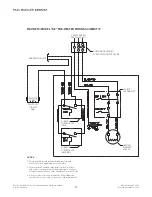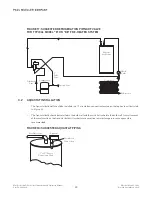
Mueller Model D Fre-Heater Installation and Operation Manual
Effective March 1, 1993
Part No. 8800430
Revised November 6, 2019
2.6 HEAT PUMPS
Mueller Model “D” Fre-Heaters may be used on commercial heat pump systems with the following precautions:
• Heat pumps are normally sized for the air conditioning design load with supplemental heat added to carry the
heating load during low ambient operating conditions.
• Most commercial heat pumps have more than enough heating capacity at ambient temperatures of 40°F and
above to provide space heat and reclaim heat for water heating.
• The Fre-Heater is a heat removing device; if the heat that it will be removing from the system will materially
affect the space heating capacity, it should be bypassed when the ambient temperature drops below 40°F.
This may be done by using a heat reclaim valve in a similar manner as for water temperature control. In this
application, the valve will be controlled by an outdoor thermostat.
• When the Fre-Heater is bypassed for low ambient operation, any condenser (outdoor coil) head pressure fan
switches must also be bypassed so the fan will run continuously in the heating mode. The water temperature
limit/hot gas bypass valve must also be wired so it is not actuated during the defrost cycle. See Figure 14 for a
refrigeration piping schematic.
2.7 ICE MACHINES
Generally, a Fre-Heater may be installed on water-cooled ice machines and remote condenser air-cooled ice
machines. These machines are usually equipped with large capacity receivers, pump down controls, and head
pressure controls. If a Fre-Heater is to be installed on a self-contained, air-cooled expansion valve refrigerant
control ice machine, the same modifications may be required as when a remote air-cooled condenser is used.
Should there be any question concerning the adverse effect of a Fre-Heater on the proper operation of any
particular ice-making machine, Paul Mueller Company and/or the ice machine manufacturer should be consulted
prior
to the installation of the Fre-Heater.
2.8
REFRIGERANT CHARGE
It may be necessary to add additional charge in some refrigeration systems. Check the sight glass and, if necessary,
add refrigerant to clear the sight glass. Final charging of the system must be done after the water in the Fre-Heater
becomes warm.
2.9 TEST RUN
Turn on the water supply and fill the Model “D” Fre-Heater with water. Ensure that all water and refrigeration
connections are leak free. The unit is then ready for use. Refrigerant charge should be checked after the system has
achieved normal operating conditions. Be sure to check for proper operation of any and all controls, valves, etc.,
installed with or changed during the installation of the Fre-Heater, both in the refrigeration and water systems.
12
















































